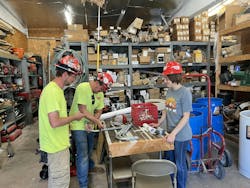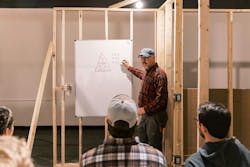You know an industry is in big trouble when a dwindling number of teens and young adults see it as a career path. For decades, electrical and other trades have lamented that problem. Now higher education is, too. But that could turn out to be a good thing — and not just because misery loves company.
Since 2016, nearly 100 U.S. colleges have closed, merged, or announced plans to do so. Some were public, while most were private. However, the reasons were often the same: declining enrollment, which means declining tuition. The prospect of taking on five or six figures of debt is a major, highly publicized turnoff for prospective students. But some observers say disenchantment is an equally important yet underappreciated factor.
“The last 10 years has seen a 10% drop in male enrollment in higher ed,” says David Michael Phelps, president of Harmel Academy of the Trades, based in Grand Rapids, Mich. “Some [colleges] are saying: ‘We’ve got to get our enrollment numbers up. We better think a little more about what we offer.’ But notice what's happening there. They're not saying, ‘Why did they leave?’”
Demographic trends also are stifling enrollment, which is why some established liberal arts colleges are expanding into the trades. One example is Stephens College, founded in Columbia, Mo., in 1833. In April 2024, Stephens launched Women in Trades, a pre-apprenticeship program.
“We have a cliff that all academic institutions are headed for: a significant reduction in the number of people that are going to be 18 years old, just due to the birth rates,” says Scott Taylor, dean of workforce development and continuing education program chair. “It's causing us to shift our focus from the traditional 18-year-old college student to looking for opportunities to serve that more nontraditional student base. This is something Stephens College has not really pursued much of in the past. We felt it was a good opportunity for us to really reevaluate what our programs are and more closely align [with] industry demands.”
And with what people are increasingly telling high schoolers: Eighty percent of Americans would recommend the skilled trades as a top career choice when advising younger generations, according to the 2024 3M State of Science Insights report. That’s ahead of STEM jobs (75%) and green jobs (70%).
The best of both worlds
Harmel is among a growing number of new colleges offering training in electrical, carpentry, and other skilled trades alongside academics such as the liberal arts. Founded in 2020, Harmel also is part of a trend within this trend: Catholic schools specializing in the trades. Its namesake is Léon Harmel, a 19th-century French Catholic industrialist who championed the dignity of manual work, which inspired two Popes to enshrine that concept in Catholic doctrine.
In a sense, colleges such as Harmel are adapting a pedagogical model from high school vo-tech programs, where students spend part of the day in academics and another learning a trade. At the collegiate level, this hybrid model means teens and young adults no longer have to choose between literature and making a good living.
“My wife Helen and I taught The Great Books at Hillsdale College and Wyoming Catholic College, but I've always been interested in the trades and was concerned that they had been divorced from the liberal arts,” says John Freeh, co-founder and president of Kateri College of the Liberal & Practical Arts in Gallup, N.M. “What was needed was a side-by-side education in the liberal arts for the sake of [students’] own humanity: for the sake of their ability to think and appreciate beauty and reason. This hybrid model helps people have a sense of pride in their manual work, but also in such a way that we don't ignore their general education.”
Getting the word out
Set to open in 2025, Kateri is aiming for an inaugural class of 30 to 40 students, similar to its peers. Altogether, that’s admittedly a drop in the bucket compared to the roughly 300,000 open construction jobs. But if these schools fill to capacity over the next few years, their success could inspire others to follow suit and attract more funding from contractors and unions.
“We're hoping to work something out whereby we can say, ‘Help us out maybe with equipment, with some scholarship money, and we could guarantee that in a couple of years, you would have a ready pool of qualified workers that you can hire,’” Freeh says.
Another key to long-term success is building awareness among prospective students, their parents, and high school guidance counselors. One way small, new colleges can do that is by leveraging their faith, such as by working with dioceses to reach their region’s churches and Catholic high schools. It also turns out that simply offering an alternative gets attention.
“We haven't done anything like a concerted marketing or recruiting campaign,” says Harmel’s Phelps. “The 21 guys we have right now come from 12 states, and that's all word of mouth. I account for that in two ways. One is we tend to get a lot of students from non-traditional schooling paths. For example, homeschooling families tend to be willing to try new things because they aren't necessarily going to pigeonhole the formation of their children into whatever's expected. Also, Catholic schools and classical [education private] schools are willing to try new things. That's a pretty tight-knit community, so word travels.”
Faculty on a mission
Another challenge is finding enough qualified faculty — especially for schools in smaller cities.
“That was one of my biggest hurdles,” says Stephens’ Taylor. “I was fortunate enough to find a retired journeyman carpenter who met the qualifications to teach the introduction courses. He's already taught carpentry to high school vo-tech students, and he's going through training to deliver the pre-apprenticeship content.”
As traditional trade schools learned long ago, academia can be a tough sell to journeymen and masters when they can make a lot more in the private sector. But some might be willing to make that pivot if they feel a calling to serve, whether it’s for religious or secular reasons.
“We want to be able to pay them, if not as much as they would make having their own business, then at least a living wage — a good wage,” says Kateri’s Freeh. “But they would have to see the value of this education almost as a kind of a calling or mission.”
In other cases, simply offering an alternative career path can be as attractive to veteran professionals as it is to prospective students.
“The faculty will be people who are skilled in the trades but at least have an appreciation for the liberal arts,” Freeh says. “That's not always an easy combination to find. I'm talking with a gentleman later today whose background is in philosophy and literature, but he also grew up in a family of construction [workers]. So he's kind of the perfect guy for us.”
Ladies first
Many of the new colleges are co-ed — good news for an underrepresented demographic.
“Nationally, 10% of the construction workforce is made up of women,” Taylor says. “I feel that's a very optimistic number. Talking to the contractors in our state, 5% is probably more realistic. So [the industry] is basically neglecting 50% of the available workforce.”
But Stephens also wanted to know why women weren’t exploring construction careers.
“One of the big things we saw was their inability to walk away from a remedial job that they have right now — a complete loss of salary — to try to get the training credentials they need to get into one of those earn-and-learn, registered mentorship programs,” Taylor says. “So while they're going through their training, we're going to pay them $15.00 an hour. We're also providing child care and, if necessary, transportation to and from our facility and any job site we utilize for training.”
Stephens also is working to make those job sites less daunting, which is another common barrier to women entering the trades.
“We're hoping to partner with contractors that are willing to put these women to work in teams of at least two [so] they have a sense of camaraderie, and they're not alone in a male-dominated workforce,” Taylor says. “A lot of our contractors have said: ‘We need people anyway. So if we can get two qualified individuals that are female, we're more than happy to put them together on a team and put them under the same super or project manager.’”
Stephens is using content from the National Center for Construction Education and Research (NCCER), which could help make Women in Trades more attractive to potential students by fast-tracking their apprenticeships and careers.
“All the union training centers have evaluated the courses that I'm offering,” Taylor says. “They're like, ‘This is going to be an opportunity for us to truncate some of the required training we'll have for those who want to go the union pathway.’ They won't have to take as many courses in that first year as they normally would.”
The more you learn
Considering that roughly 100 colleges have closed in recent years due to financial pressures, it might come as a surprise to learn that Stephens didn’t develop Women in Trades to create a new revenue stream.
“We're not making any money on this,” Taylor says. “It’s actually costing us money because we're funding this internally. We see it as an opportunity to open the door and hopefully develop a model that will then be attractive to sponsors and grant organizations.”
Another surprise is that the inaugural class includes a few college graduates who believe hands-on training will give them a leg up.
“Two graduating seniors with a bachelor's degree in business administration with a management emphasis are going into the program,” Taylor says. “[They want] to get an apprenticeship and then work their way up to project manager in a construction firm.”
Another type of interdisciplinary study is underway at The College of St. Joseph the Worker in Steubenville, Ohio, where students get exposure to multiple trades during their first year.
“So when students get into their specific trade and specialize, they will have at least a fundamental knowledge of all the other trades,” says Mike Sullivan, president. “One of the things I've seen on the job in my career is that the different tradesmen don't consider the effects that their work might have on others. We give them the full scope of a residential build from start to finish. It's one of the innovations that we think will help an electrician be a better electrician and a plumber be a better plumber.”
This approach also benefits students who want to learn a trade but aren’t sure which one — like students who enroll in liberal arts colleges as undeclared majors.
“There's a year of discernment before a student just jumps into something that their uncle or somebody recommended,” Sullivan says. “They actually get their hands on it and see what they'd like to do before committing. The first year, they're not committed to a specific trade. They'll do that at the beginning of their second year. I think it will help with retention, too, because then they're making a decision based on actual experience rather than just what they think about something.”
About the Author
Tim Kridel
Freelance Writer
Kridel is an independent analyst and freelance writer with experience in covering technology, telecommunications, and more. He can be reached at [email protected].



